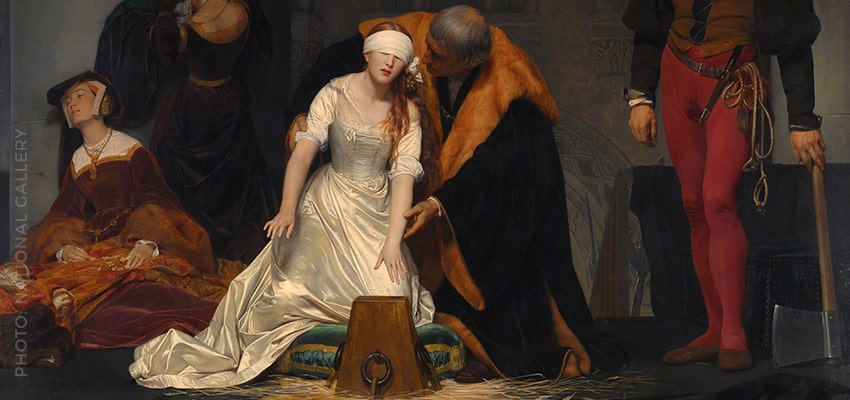The Tower of London is a historic castle built on the River Thames in the city’s center. It was founded in 1066 as part of the Norman Conquest of England. Like other places with a past filled with skullduggery and fear, the Tower is said to be haunted. Most of the ghosts are unfortunate souls who met an untimely–and many times unjust–death. (Including death by grizzly bear.) On your London vacation, visiting the Tower, regardless of questionable spooks, is a must. Here are thirteen spirits that are most often reported.
Anne Boleyn
The second wife of Henry VIII, and the first wife he executed, Anne is the most famous and persistent of all Tower ghosts. She is seen on the Tower Green where she was executed, in St. Peter ad Vincula where she was buried, and wandering corridors as a headless body.
Henry VI
He met his end as the result of a real-life game of thrones. Henry VI stood to inherit both the English and French thrones, but the House of York imprisoned him during the War of the Roses. Shortly after Edward IV seized the throne in 1471, Henry VI was stabbed while praying in Wakefield Tower, which his ghost haunts to this day. He appears at the last stroke of midnight.
Lady Jane Grey
She was only queen for nine days before being executed by Mary Tudor, aka Bloody Mary, along with Lady Jane’s husband, Lord Guildford Dudley. Jane was advanced as an Anglican alternative to the Catholic Mary. Lady Jane Grey’s ghost is seen wandering the battlements, a lonely, solitary figure.
Lord Guildford Dudley
Lord Guildford Dudley’s ghost haunts Beauchamp Tower, sitting in his cell and weeping late into the night. Lord Dudley is also said to be responsible for the word “Jane” etched into the wall.
Margaret Pole, Countess of Salisbury
Margaret was a victim of one of the most gruesome, botched executions in history. When the Countess reached the scaffold where she was to be beheaded, she refused to kneel, saying, “So should traitors do, and I am none.” When the executioner raised his axe, she ran – and he chased her all around the scaffold, hacking at her until she died a gory death. Her ghostly screams can still be heard on the Tower Green and a few visitors claimed to have seen a ghostly reenactment of the chase.
The White Lady
No one is sure who the White Lady is, but she haunts the White Tower. Her presence is typically announced by an overwhelming smell of cheap perfume, so strong it has made several Tower visitors sick. A few visitors report being tapped on the shoulder, only to turn around and see nothing but a wisp of white.
The Princes (Edward V and Richard, Duke of York)
These boy princes were imprisoned in the Tower by their uncle, Richard, Duke of Gloucester (Richard III) and purportedly murdered on his order. When the bones of two small boys were found under the stairs in 1674, most people believed them to be the missing princes and the bones were given a royal burial at Westminster Abbey. The figures of two lost little boys wearing nightshirts, holding hands, are frequently seen in the White Tower. Oddly enough, they have also been seen playing on the battlements and some claim to have heard children giggling.
Sir Walter Raleigh
Sir Walter Raleigh was imprisoned in the Tower twice, once for a secret marriage and once for treason. Following his execution, his ghost began wandering around the Bloody Tower (where he was imprisoned) as well as along the battlements now known as Raleigh’s Walk.
They Grey Lady
Her identity in life is uncertain, but the Grey Lady is a well-known resident of the Queen’s House. The Grey Lady will only reveal herself to female visitors.
Arbella Stuart
King James I did not give his permission for Arbella to marry William Seymour, nephew of Lady Jane Grey. Enraged at the insult, and perceiving the marriage as a possible threat to his throne, James I imprisoned Arbella in the Tower. She died there in 1615—conflicting reports claim she either stopped eating or was murdered. She haunts the Queen’s House.
Guy Fawkes
It is said that you can hear Fawkes’s screams and cries from the Council Chamber in the White Tower, where he was prepared for his execution.
The Smothering Force
A number of spectral animals have been heard over the years, including monkeys, lions and horses, but only one has actually been seen. A guard at the Tower claimed a ghostly bear charged him. Though the guard attempted to bayonet the animal, which kept coming at him, soon the sword went through the animal. The guard was carried, senseless, to his quarters where he died two days later.
The Grizzly Bear
A number of spectral animals have been heard over the years, including monkeys, lions and horses, but only one has actually been seen. A guard at the Tower claimed a ghostly bear charged him. Though the guard attempted to bayonet the animal, which kept coming at him, soon the sword went through the animal. The guard was carried, senseless, to his quarters where he died two days later.
When the Tower was built, it was a resented symbol of repression, inflicted upon the inhabitants of London by a new, ruling elite. It was used as a prison from 1100 until 1952, although that wasn’t its main purpose. Early on, it was a royal residence and a grand palace. The peak period of the castle’s use was as a prison during the 16th and 17th centuries. During this time, many figures who had fallen into disgrace were sent to the Tower. Today, visit the Tower of London and feel the history, the stories, and perhaps get a glimpse of a resident spirit. View England vacations here.


















